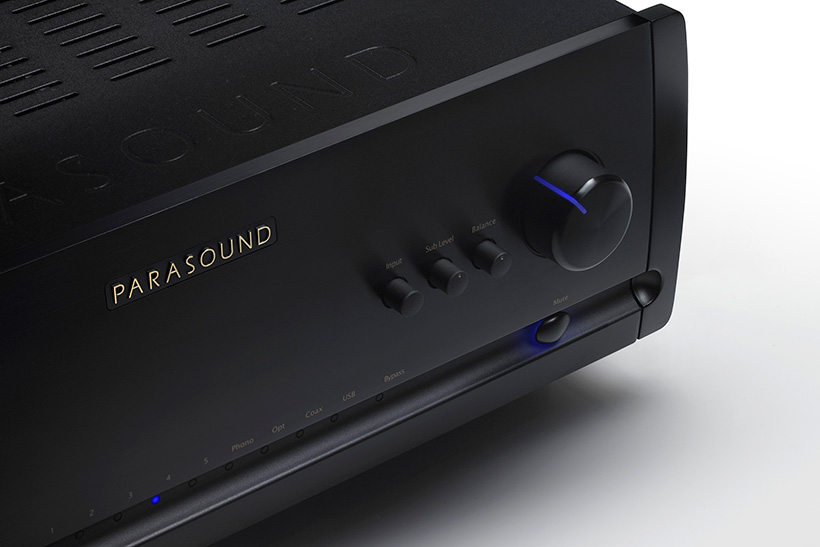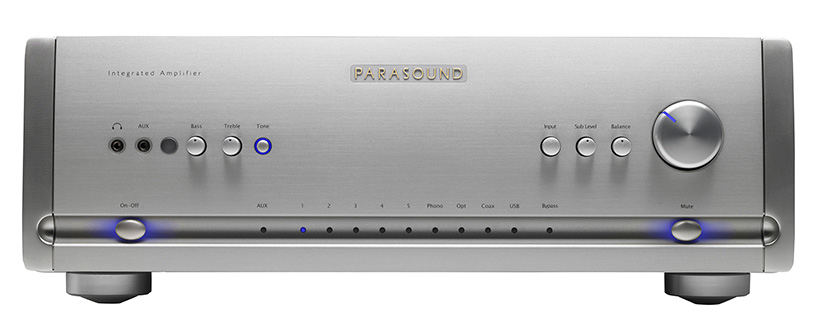Despite being 35 years old the Halo Integrated or Hint is the first integrated amplifier that Parasound has made. It’s not clear why it took them this long but it may be something to do with the companies enthusiasm for offering more features than you can shake a stick at in products that have audiophile aspirations. In Europe the ethos is the fewer the features the better, hence the more ambitious Naim amplifiers are so feature poor that they are almost hairshirt. This situation is not as extreme as it was 25 years ago when a balance control was considered a frivolity but the mind set lives on, less is generally considered more. Parasound understands that its customers want everything all the time, they want great sound and plenty of knobs and buttons, and in the Hint they have got pretty close to delivering it.
This is a 2.1 channel amplifier with 160 Watts per channel, onboard DAC, tone controls, home theatre bypass, balanced and single ended connections, phono stage and tone controls, oh and a headphone output for good measure. And these aren’t throwaway add ons, the DAC is good for up to 32-bit/384kHz PCM and DSD up to 256 while the phono stage will work with MM and MC cartridges and offers alternative loadings. That 0.1 subwoofer output isn’t an afterthought either, you can adjust level and manage what frequencies go to it with high and low pass analogue crossovers. I guess that’s the feature that gives its US origins away more than most, in the UK 2.1 systems are pretty rare. The power amp is a dual mono design with a direct input should you want to incorporate a standalone preamplifier, and while it seems an unlikely upgrade this is the area where most integrated amps fall down.

The Hint is a substantial piece of kit with a thick front plate and a densely packed back panel, this includes 12 volt triggers, IR in- and output loops, digital and analogue inputs of most varieties and both sub and pre output controls. Cartridge loading extends to three settings for both types so there are two levels of gain and as many impedance options, it’s not a lot but more than most integrateds offer. The final bell/whistle is a remote handset that’s dedicated to this product or at least seems that way, it is pretty intuitive but has the novelty of separate on and off buttons to keep you guessing for a while.
As they happened to be in the system when the Parasound arrived I started out using the amp’s USB input and Bowers & Wilkins 803 D3 speakers, which while an unlikely partner given the price discrepancy (the 803s are £12,500) worked rather well. The midrange was a little dark but this didn’t stop decent levels of detail getting through and doing so in a pretty timely manner, enough to let the tension in the music be heard and make it more engaging. Image width was excellent with Trentmoller’s ‘Chameleon’ and the bass, while not being as solid as a separate power amp, was reasonably well controlled given the challenge that this speaker undoubtedly represents.

Moving over to a high quality analogue source (CAD 1543 MkII DAC) and PMC Fact.8 floorstanders which have a lighter balance and a different, slightly easier, load proved to be a better match for the Parasound. Now the timing was happening and pieces like Radiohead’s ‘Identikit’ (A Moon Shaped Pool) started to get interesting, not least the guitar break if it can be called that, which had excellent tone and definition. Brass worked well with this album as well and further reinforced the positive impression of the amp’s timing abilities, thanks to bass lines that stayed with the mid and treble. Timing often comes down to bass control, if an amp can’t stop and start the bass drivers effectively then the overall quality of coherence falls down. This is one of the key factors at the heart of good amp/speaker matching.
The mid was still on the mellow side which meant that it was possible to play at higher levels without discomfort, but it does undermine absolute transparency. At this price there are always compromises to be made and Parasound has chosen to trade off maximum resolution in favour of a softer balance that doesn’t expose shortcomings in the source nor let the speakers scream when the level is pushed.
With the USB output of a Melco N1-A digital server the lovely expansiveness of image experienced with the analogue input continued, it also has plenty of dynamic range for Susumu Yokota’s sublime ‘Tobiume’. This is an electronic piece that starts quietly and builds, it needs level to work properly and the Parasound is equal to the task of delivering both the quiet clarity of the beginning and the scale of the crescendo. Doug MacLeod’s ‘Too Many Misses’ is a more purist recording of some lovely blues played live in a reverberant room, here the bass could have done with a bit more grip but the overall control at higher levels was very good, the saxophone tone in particular delivering a delicious liquorice tone. Miles Davis’ Agharta bubbles with atmosphere, the sonic fog created by numerous carefully orchestrated instruments creating a cracking background to the man’s horn work. It’s a full immersion experience that is very easy to enjoy, and that for me at least, has always been the point of a sound system.

The moving coil input doesn’t have quite enough gain for a Rega Apheta 2 cartridge (350μV output), you can wind up the volume of course but the image is still a bit small scale. A moving magnet (Rega Elys2) worked best with the higher gain setting and the expected 47kOhm impedance, sounding slightly soft but delivering nice fluidity and transparency to the groove.
Using ATC SCM11 speakers, which are not the easiest of loads, proved enjoyable as well. They soaked up more power than the PMCs but produced a big, open soundstage with good timing and excellent imaging in the Hint’s hands. Voice in particular sounded very good indeed, Patricia Barber’s specifically was very convincing. I also enjoyed Beethoven’s 7th (Barenboim, Beethoven For All Symphony No.7 in A, Op.92 (24/96, Decca) where the Parasound’s ability to deliver a good portion of the scale and dynamics gives you the grandeur of the piece without strain. Out of interest I tried bypassing the preamp section and used a Townshend Allegri passive controller instead, this brought a useful increase in transparency and revealed layers of detail that were previously masked.

My final speaker choice was a bit more down to earth, the Dynaudio Emit 20 is a £599, two-way stand mount, but that did not stop it making some of the most enjoyable sounds I got with the Hint. The detail level was not up with the bigger speakers but the timing and musical flow was perhaps better because this speaker is easier to control and two-ways seem intrinsically inclined to good coherence. Again voice was a strong point but so was a range of music types, the midrange seemed to have greater transparency which probably means that it has better definition of the fundamentals and doesn’t try to give you so much of the fine detail. But either way this was a great partnership and proved that the Parasound is capable of addictive musicality when you find a good speaker match.
It also proves that you can have your cake and eat it, features are not a barrier to resolution and good timing as is often suggested by those in the less is more camp. The Parasound Hint does an awful lot for the money but it gets the important thing right, it makes you want to listen to more music.


